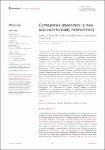Comparative phenomics: a new approach to study heterochrony
| dc.contributor.author | McCoy, JCS | |
| dc.contributor.author | Spicer, JI | |
| dc.contributor.author | Rundle, SD | |
| dc.contributor.author | Tills, O | |
| dc.date.accessioned | 2024-01-19T12:31:29Z | |
| dc.date.available | 2024-01-19T12:31:29Z | |
| dc.date.issued | 2023-11-06 | |
| dc.identifier.issn | 1664-042X | |
| dc.identifier.issn | 1664-042X | |
| dc.identifier.other | ARTN 1237022 | |
| dc.identifier.uri | https://pearl.plymouth.ac.uk/handle/10026.1/21921 | |
| dc.description.abstract |
Understanding the links between development and evolution is one of the major challenges of biology. ‘Heterochronies’, evolutionary alterations in the timings of development are posited as a key mechanism of evolutionary change, but their quantification requires gross simplification of organismal development. Consequently, how changes in event timings influence development more broadly is poorly understood. Here, we measure organismal development as spectra of energy in pixel values of video, creating high-dimensional landscapes integrating development of all visible form and function. This approach we termed ‘Energy proxy traits’ (EPTs) is applied alongside previously identified heterochronies in three freshwater pulmonate molluscs (<jats:italic>Lymnaea stagnalis</jats:italic>, <jats:italic>Radix balthica and Physella acuta</jats:italic>). EPTs were calculated from time-lapse video of embryonic development to construct a continuous functional time series. High-dimensional transitions in phenotype aligned with major sequence heterochronies between species. Furthermore, differences in event timings between conspecifics were associated with changes in high-dimensional phenotypic space. We reveal EPTs as a powerful approach to considering the evolutionary importance of alterations to developmental event timings. Reimagining the phenotype as energy spectra enabled continuous quantification of developmental changes in high-dimensional phenotypic space, rather than measurement of timings of discrete events. This approach has the possibility to transform how we study heterochrony and development more generally. | |
| dc.format.extent | 1237022- | |
| dc.format.medium | Electronic-eCollection | |
| dc.language | eng | |
| dc.publisher | Frontiers Media SA | |
| dc.subject | phenomics | |
| dc.subject | heterochrony | |
| dc.subject | evolution | |
| dc.subject | development | |
| dc.subject | embryo | |
| dc.subject | bio-imaging | |
| dc.title | Comparative phenomics: a new approach to study heterochrony | |
| dc.type | journal-article | |
| dc.type | Article | |
| plymouth.author-url | https://www.ncbi.nlm.nih.gov/pubmed/38028775 | |
| plymouth.volume | 14 | |
| plymouth.publication-status | Published online | |
| plymouth.journal | Frontiers in Physiology | |
| dc.identifier.doi | 10.3389/fphys.2023.1237022 | |
| plymouth.organisational-group | |Plymouth | |
| plymouth.organisational-group | |Plymouth|Research Groups | |
| plymouth.organisational-group | |Plymouth|Faculty of Science and Engineering | |
| plymouth.organisational-group | |Plymouth|Faculty of Science and Engineering|School of Biological and Marine Sciences | |
| plymouth.organisational-group | |Plymouth|Research Groups|Marine Institute | |
| plymouth.organisational-group | |Plymouth|REF 2021 Researchers by UoA | |
| plymouth.organisational-group | |Plymouth|Users by role | |
| plymouth.organisational-group | |Plymouth|Users by role|Academics | |
| plymouth.organisational-group | |Plymouth|REF 2021 Researchers by UoA|UoA07 Earth Systems and Environmental Sciences | |
| plymouth.organisational-group | |Plymouth|Admin Group - REF | |
| plymouth.organisational-group | |Plymouth|Admin Group - REF|REF Admin Group - FoSE | |
| plymouth.organisational-group | |Plymouth|Users by role|Researchers in ResearchFish submission | |
| plymouth.organisational-group | |Plymouth|REF 2028 Researchers by UoA | |
| plymouth.organisational-group | |Plymouth|REF 2028 Researchers by UoA|UoA07 Earth Systems and Environmental Sciences | |
| dc.publisher.place | Switzerland | |
| dcterms.dateAccepted | 2023-10-02 | |
| dc.date.updated | 2024-01-19T12:31:29Z | |
| dc.rights.embargodate | 2024-1-20 | |
| dc.identifier.eissn | 1664-042X | |
| rioxxterms.versionofrecord | 10.3389/fphys.2023.1237022 |


